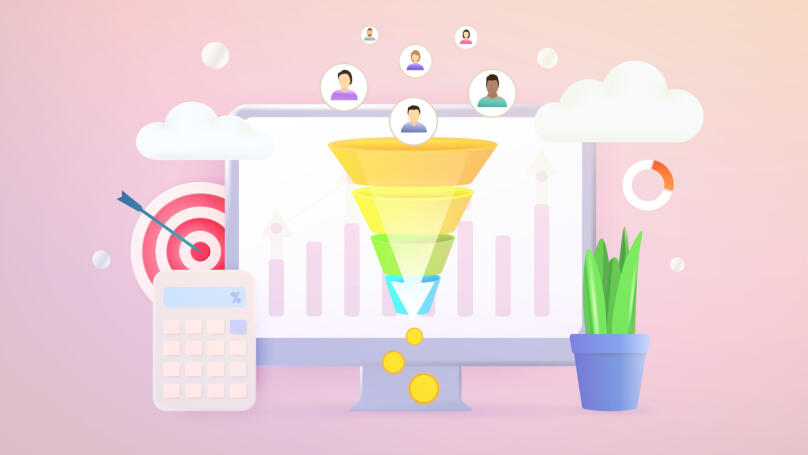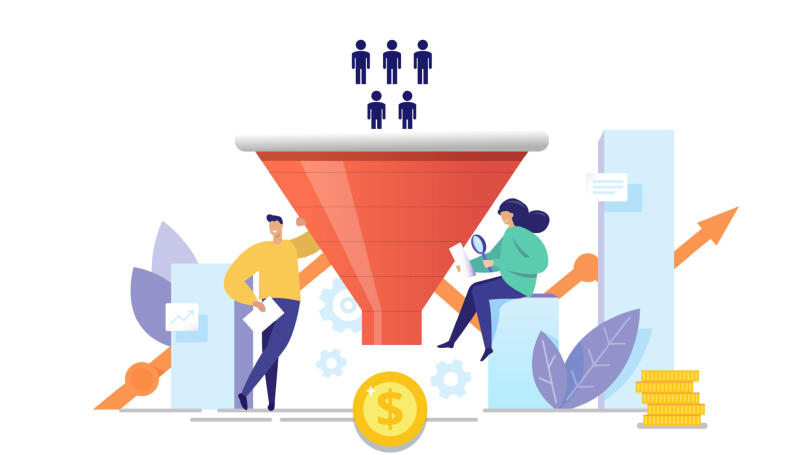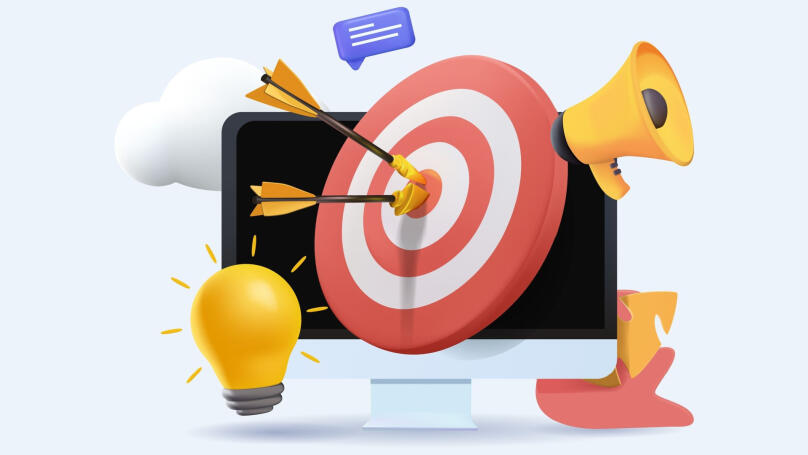Lead Generation

What is lead generation?
Lead generation is a process whereby various marketing tools collect data on potential customers interested in a company's products or services. Lead generation is getting customers to leave their contacts, such as phone numbers, emails, or social media links. It allows customer retention and continued interaction even if they are not ready to purchase. An equally important goal of lead generation is to convert visitors to a company's website or social media accounts into potential customers. Thus, lead generation helps to expand the customer base, increase sales and, consequently, profits.
It is essential to clarify that leads in marketing are representatives of the company's target audience or a particular product. Also, a lead can come directly from the client's contact information. Understanding that a lead goes through several stages before purchasing and becoming a brand client is essential. First, they learn about the product or service, after which comes the interest and desire to buy the product. Next, the potential lead considers alternative products and decides what is more appropriate to buy. They proceed to action only after the decision gets made; that is, they decide to purchase the product and become a company client. However, this is not always the case. Leads also come in different forms, for example.
- Cold leads are contacts from people not yet interested in the company's products or services. They visited the site and left their contacts out of curiosity, not intending to buy anything immediately. However, you can influence such communications through newsletters about various promotions, coupons, and promo codes.
- Warm leads are data from users interested in the company's offers. For example, they fill out forms on the site, leave requests in the hope of feedback, ask clarifying questions in chat, and so on.
- Hot leads are contacts of consumers who are already ready to buy. Most often, they are regular customers or those who urgently need a particular product. Hot leads are the most priority and profitable for business; these customers do not need to be additionally motivated and persuaded to buy.
Thus, lead generation is the collection of data about all these users. The advantages of obtaining information about customers are apparent:
- Attracting new customers and maintaining a trusting relationship with a loyal audience;
- Increase in sales. Lead generation helps to bring the client directly to the purchase of goods because the more contacts you collect and the more competent you build communication with the audience, the more you can earn;
- An increase in conversion because attracted customers are already interested in the company's products or services and are more likely to take some targeted action on the site;
- Saving time and resources since lead generation automates the process of attracting customers.
However, lead generation also has disadvantages. For example, this process can be quite costly in terms of time and resources. Lead generation requires the efforts of technical specialists and the configuration of special software. However, even this will not ensure a regular flow of new customers, because not all leads are immediately ready to buy and cooperate with the company.
How lead generation works

The process of lead generation consists of several main stages:
Stage 1. Identifying the target audience
First, suppose a company or a particular product has just entered the market. In that case, it is necessary to identify among the entire mass audience those who will be interested in the goods or services of the brand. You can separate the audience by age, income level, marital status, hobbies, gender, etc. Most importantly, the company must meet its audience's needs, see what goods and services they need, and learn their requirements for specific products. Depending on the information obtained, it will be easier for the brand to attract new and retain regular customers.
Stage 2. Creating quality content
Content plays an essential role in lead generation because it helps attract the attention of potential customers and convince them to become brand buyers. For a company's possible audience to go to its website or social media accounts, it must create informative and attractive content. It is valuable information that should interest leads and motivate them to go to the website and buy the product. And thanks to the previous stage of analysing the target audience, the company already has an idea of what topics are attractive to potential customers and in what form it is most convenient for them to perceive the content.
Stage 3. Attracting traffic
This stage involves advertising campaigns and SEO-optimisation of the site. After all, the more traffic the website gets, the higher the probability that the company will attract new customers and increase sales.
Stage 4. Collecting and evaluating contacts
For users to leave their contact information, creating forms consisting of several fields to get filled with information is necessary. Contacts collected during the lead generation process are one of the essential tools in building effective communications with potential customers. Assess the quality and value first to determine the potential and effectiveness of lead generation. Thus, at this stage, it is crucial to analyse and determine to what extent the users who left their data are already interested in the company's goods or services, whether they have made a purchase earlier or performed another target action.
Stage 5. Building a relationship with the company and turning leads into customers
It would be best to build trust in the brand and the desire to cooperate through direct or indirect influence tools (i.e., email newsletters, calls to customers, invitations to events, consultations, and so on). Remember that retaining existing customers is much more effective and cheaper than finding new ones. It is also essential to respond quickly to customer requests, build an individual approach to each customer and consider their interests, opportunities, financial habits, and fears.
Types and channels of lead generation

Depending on how the company interacts with customers and carries out lead generation, there are several varieties of it:
-
Internal or Outbound Lead Generation
In this case, the company searches for and collects data on potential customers, for example, through direct calls to consumers to identify needs and level of interest in the offer, and sometimes directly for sales. In addition, outbound lead generation can include email newsletters, online surveys and chatbots, which represent round-the-clock customer support and quick answers to questions. Such customer information collection methods are especially relevant for the B2C market segment.
-
External or Inbound Lead Generation
Potential customers find the company themselves, for example, through search engines and leave their contact information on the website or in a particular form.
-
Lead Generation Through Content Marketing
Simply put, the company creates and distributes valuable content for its audience, which helps attract new customers and retain regular ones.
-
Lead Generation Through Social Media
In this case, the company uses various platforms such as Instagram, Facebook, and LinkedIn to engage customers and gain insights about their needs, interests, and capabilities.
-
Lead Generation Through Events and Activities
The company attracts potential customers and motivates them to become regular customers of the brand by organising seminars, conferences, workshops, and master classes, which you can sign up for by leaving your phone number or email address.
Lead generation channels are platforms or tools to attract potential customers, i.e., leads. Depending on the type of lead generation channels, you can divide them into two main kinds.
- Offline Channels
Such channels for attracting customers advertise on billboards and distribute leaflets, flyers, and other printed products. They can also be phone calls and business meetings most appropriate in B2B sales. Before a personal or telephone conversation, you should consider the scenario of the future discussion in detail, make a list of questions to ask the client and prepare arguments and counterarguments. Additionally, various events such as conferences, exhibitions and master classes represent an offline channel of lead generation. Attending such speeches related to the company's activities will allow you to get acquainted with potential brand customers and establish contact with them. Also, you can obtain their data with the help of a form offered to fill out to register for the event.
-
Online Channels
The possibilities of lead generation on the Internet are almost unlimited. So, to get information about customers and attract new audiences, you can use:
- Social media
They are convenient platforms for increasing brand awareness, increasing customer loyalty and building a target audience around the company's social media profile. Simultaneously, an essential element in using social media for lead generation is the presence of high-quality, in-demand and valuable content. A brand should provide its followers with information that will collect likes, reposts, and comments and actively spread across the network. Additionally, use various tools for the most effective use of social networks for lead generation purposes.
For example, to increase the number of followers and contacts, you should organise contests, with the prize being a new product of your brand, as well as promotions and surveys. You can also use live broadcasts and stories to improve interaction with the audience. Thus, quality social media management can improve the company's image, increase its awareness, and help attract more leads. To monitor user activity and get feedback, you should use metrics such as evaluation of coverage, conversion, audience engagement level, and so on.
- Email newsletters
Emailing lists can become an effective tool for lead generation if you use its capabilities competently. To begin with, you should make a list of addressees who will be interested in the offered product, service, or brand content. In addition to regular customers, it can be, for example, your followers on social media. Next, you need to create content that is useful and in demand among the potential audience. For instance, it can be a guide on using a new product, a promo code or coupon for a particular group of products, a video review, an invitation to an upcoming master class, and so on. However, even this is not enough. A newsletter email must have a bright and memorable headline to attract the client. Usually, a large and contrasting text is used for it, containing one main idea and call to action, for example, to go to the website, subscribe to social networks or directly buy the product.
- Search engines
Knowing the most frequent queries of users will help a company raise its website in search engine rankings and increase lead generation. Also, a common way of using search engines for lead generation is contextual advertising, which adjusts to the user and shows them the offers they are already interested in. Thus, contextual advertising works according to the key queries of users. The company only needs to select the words for which the ad gets shown correctly. If contextual advertising is set up well, it will attract hot leads to the site, immediately ready to make a purchase. But marketers also often use targeted advertising aimed at the audience united by common characteristics, such as gender, age, social status, and income level. That is, advertisements are shown only to the audience that fits the given parameters and is the most promising and interested in buying the brand's goods.
- Referral programme, or the word-of-mouth advertising method
It is a way to promote a brand, its products, or services through recommendations. Thus, the company's existing regular customers help attract new leads. For example, you could offer a discount or bonus for recommending the brand's products to their friends, colleagues, or acquaintances. In general, a referral programme can become an effective channel of lead generation and a tool for increasing customer loyalty and strengthening the brand's positive image.
Lead generation tools

So, each channel of lead generation has its tools for its realisation. In this case, email marketing, social media, content marketing, and contextual and targeted advertising are channels. On the other hand, they get considered independent tools for attracting leads. In addition, there are other opportunities to implement and simplify the lead generation process. When leads are interested in the company's offer and have performed an action, such as going to the website, it is time to ask them to leave their contact info. You can do it using the following tools:
- Online Chats
In this case, the manager must always stay in touch with customers promptly and answer all their questions. After the user has received a response to their request, the company employee asks them to leave their contact information for feedback. However, to simplify this process, the following tool has become increasingly common.
- Chatbots
In addition to asking the customer to leave their phone number or any other contact information, chatbots can help the user decide on a product, tell them about new products, find a discount program, and answer any questions. It allows consumers to put less effort into searching for the information they seek and managers to avoid one-size-fits-all queries.
- Pop-Up Windows
So-called pop-ups are small banners appearing after the user has visited the site. Their primary purpose is to involve the user in the sales funnel, i.e., to buy a product, subscribe to a newsletter and leave a contact. So, in a pop-up window, managers place a particular form for these actions, so pop-ups get placed primarily to attract leads. And for subscribing or leaving their contact information, the brand often offers all kinds of bonuses, such as promo codes, coupons, discounts, or a direct lead-magnet - a free product, such as a checklist.
- Lead Forms
Lead forms are also one of the tools for collecting contact data of users. It represents a form with fields for filling in, in which the user enters information about themselves, such as name, email address, and phone number. For the B2B sphere, there can be a separate field for the position in the company. With the help of the information received from the user, it is possible to prepare an offer or product that interests them. However, it is essential to remember that there should not be too many such fields in your form.
To further maintain constant contact with customers, use the following tool:
- CRM (Customer Relationship Management) system
CRM isn't just software but also a whole information system which stores a complete database with contacts, purchase history, lead status and other user data of the company's customers.
Thus, lead generation allows you to attract new customers and build long-term trusting relationships with them. In the future, this will contribute to increased sales, profit growth, and customers satisfaction. After all, lead generation also helps the company learn more about its audience, needs, and desires, allowing it to optimise its marketing and sales strategy.























